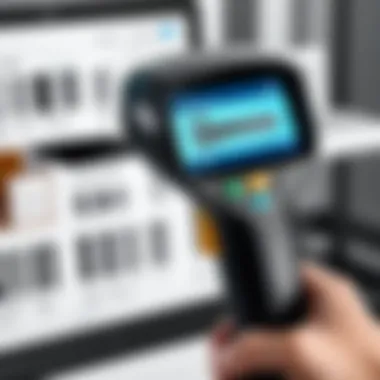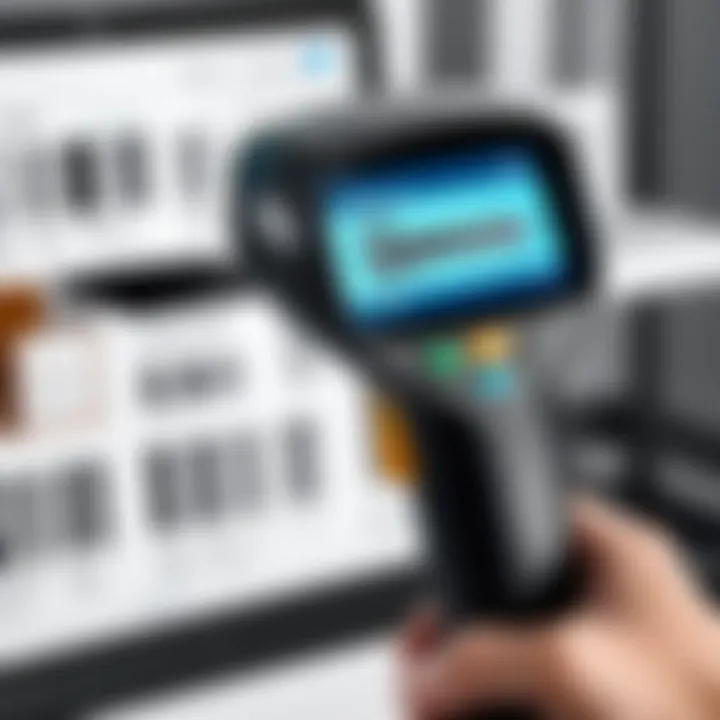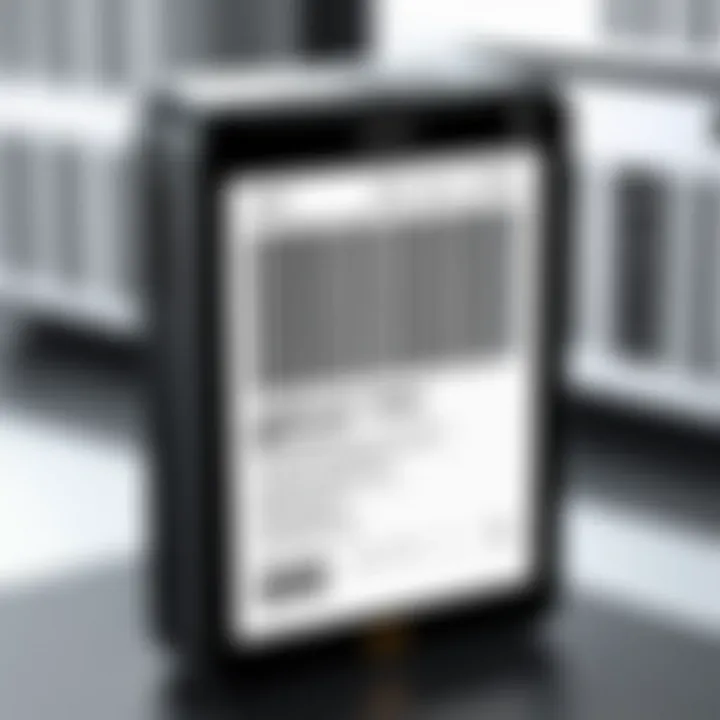Exploring Barcode Scanning Inventory Systems


Intro
The realm of inventory management has undergone significant transformation over the years. One of the most impactful innovations is barcode scanning technology. This advancement has paved the way for enhanced accuracy and improved system efficiency. Proper inventory tracking is essential for businesses seeking operational excellence. Barcode scanning inventory systems represent not just a tool, but a fundamental solution that enables organizations to monitor stock effectively.
Understanding the components, benefits, and challenges associated with these systems is crucial for decision-makers. In this article, we will explore various facets of barcode scanning, including an overview of relevant software categories and an analysis of the leading solutions on the market.
Software Category Overview
Definition and Importance
Barcode scanning software plays a pivotal role in the functionality of inventory management systems. It allows for the conversion of encoded data from barcode images into readable text. This helps in tracking goods, managing inventory levels, and minimizing errors that often arise in manual processes.
The importance of such software cannot be overstated. It streamlines operations, fosters accurate record-keeping, and ultimately influences the bottom line positively. With real-time data updates, organizations gain immediate insights into stock levels, leading to informed decision-making.
Key Characteristics
When evaluating barcode scanning software, consider the following key characteristics:
- User-Friendly Interface: Intuitive design encourages adoption among staff.
- Integration Capabilities: Seamless integration with existing systems enhances functionality.
- Customizable Options: Flexibility to meet specific organizational needs is paramount.
- Real-Time Data Access: Immediate updates that allow for quick responses to inventory changes.
By identifying these features, decision-makers can select a solution that aligns closely with their operational objectives.
Comparative Analysis of Top Software Options
Feature Comparison
Each barcode scanning software comes with distinct features. Understanding these differences is essential. Some of the highlighted features across popular software include:
- Inventory Tracking: Maintains accurate stock levels through continuous updates.
- Reporting Tools: Comprehensive analytics for performance and forecasting.
- Barcode Generation: Ability to create unique barcodes for various products.
Analyzing how these features stack up against one another will assist organizations in determining which software best suits their operational needs.
Pricing Models
Pricing remains a crucial factor in decision-making. Different models exist for barcode scanning solutions:
- Subscription-Based: Month-to-month payments that can be flexible.
- One-Time License Fee: A single upfront cost for perpetual access.
- Freemium Models: Basic features available for free, with pricing for advanced tools.
When selecting a pricing model, businesses should consider future costs along with their current budget constraints.
"Investing in the right inventory management solution today can lead to substantial cost savings tomorrow."
Understanding Barcode Scanning Systems
In today's fast-paced environment, efficient inventory management is crucial. Understanding barcode scanning systems is essential for decision-makers and entrepreneurs as they provide a sophisticated method to monitor and manage stock effectively. These systems enhance precision, streamline operations, minimize errors, and ultimately lead to significant cost savings.
By grasping the fundamental aspects of these systems, businesses can optimize their supply chain processes. Enhanced tracking of products not only boosts productivity but also improves customer satisfaction. It is vital to comprehend how these systems work in both concept and execution. This section will elucidate the definitions and historical evolution of barcode scanning technology, setting the stage for exploring its components and applications.
This foundational understanding will also allow organizations to make informed decisions regarding the implementation and integration of barcode technology into their existing infrastructure. With this knowledge, one can appreciate the value that barcode scanning systems bring to various industries, enhancing overall operational efficiency.
Definition and Basic Concepts
Barcode scanning systems refer to technologies that utilize optical scanners to read printed barcodes. These barcodes are typically series of parallel lines of varying widths and spaces, each representing a specific numeral or alphanumeric code. The main purpose of these systems is to enable quick data capture, facilitating automatic identification and tracking of inventory items.
The primary components of barcode systems include the barcode itself, the scanner, and the inventory management software. The barcode acts as a unique identifier for each item, while the scanners read these codes and transmit the data to software that processes and manages this information.
Incorporating barcode scanning offers a wide range of benefits such as reducing human error, expediting data entry, and improving tracking capabilities in real-time. All these factors contribute to more effective inventory control and decision-making processes within organizations.
History of Barcode Technology
The history of barcode technology dates back to the early 1950s when an inventor named Norman Joseph Woodland started working on a system for tracking products in grocery stores. This idea led to the development of the first barcode, which utilized a series of concentric circles known as the bull's-eye. However, it wasn't until 1974 that the first actual barcode was scanned in a grocery store, changing retail operations forever.
Over the decades, barcode technology has evolved significantly. The original 1D barcodes have gradually given way to more advanced forms like QR codes and 2D barcodes, offering greater data storage capacity. Barcodes are now widely used across various industries, not just in retail. The ability to quickly and easily find information through a scan has made them pivotal in manufacturing, logistics, healthcare, and more.
As businesses continue to advance their operations, understanding the historical significance of barcode technology can provide valuable context for its current and future applications. This knowledge is vital for those involved in selecting systems that will shape the future efficiency of inventory management.
Components of Barcode Scanning Inventory Systems
Understanding the components of barcode scanning inventory systems is vital for enhancing the overall efficiency and accuracy of inventory management. Each component plays a significant role in the seamless operation of the entire system. These components not only serve distinct purposes but also work together to support inventory tracking and control processes. By exploring the hardware and software elements, organizations can make informed decisions that lead to successful implementation and utilization of barcode scanning inventory systems.
Hardware Requirements
Barcode Scanners
Barcode scanners are critical devices in any inventory management system. They convert the optical data from barcodes into digital form for processing by a computer. The most noteworthy characteristic of barcode scanners is their speed. They can scan and read barcodes much faster than manual entry can. This speed not only enhances operational efficiency but also minimizes data entry errors.


A unique feature of barcode scanners is their versatility. They can be used in various environments, from retail to warehousing. However, it is essential to consider their durability, especially in challenging environments like warehouses where they may be exposed to dust or drops. Choosing a robust barcode scanner can lead to fewer replacements and, thus, cost savings.
Computers and Mobile Devices
Computers and mobile devices serve as the backbone for processing the data captured by barcode scanners. They are indispensable as they provide the necessary interface for inventory management software. The key characteristic of computers and mobile devices is their ability to network, allowing users to access real-time data from different locations. This functionality is extremely beneficial for businesses with multiple inventory locations.
Moreover, mobile devices, such as tablets and smartphones, offer the unique advantage of portability. This allows staff to perform inventory checks without being tethered to a desk. However, it is crucial to ensure that the software used on these devices is optimized for mobile usage to avoid functionality constraints.
Printers
Printers are essential for generating labels that carry barcodes, allowing for easy tracking during the inventory lifecycle. The defining characteristic of printers, specifically thermal printers, is their ability to print high-quality, scannable labels quickly. This speed contributes to a more efficient inventory process.
Thermal printers offer the unique feature of producing labels that are resistant to fading, which can be a disadvantage for standard inkjet printers. Utilizing durable labels helps maintain the readability of barcodes over time, a crucial factor for effective inventory management. However, businesses need to consider the ongoing costs of label materials and printer maintenance when implementing printers as part of their inventory systems.
Software Components
Inventory Management Software
Inventory management software is central to the operational efficiency of barcode scanning systems. It allows organizations to track inventory levels in real time, facilitating easier reordering and stock management. The critical characteristic of such software is its ability to integrate various functions, including sales tracking and order management. This integration ensures that businesses can have a holistic view of their inventory and sales processes.
An important unique feature of inventory management software is its analytical capabilities. Many software solutions provide insights through various reports, aiding decision-making. However, the software can come with a steep learning curve and ongoing costs for updates, which organizations must consider.
Cloud-Based Solutions
Cloud-based solutions offer significant advantages in terms of accessibility and collaboration. They enable users to access inventory data from anywhere, which is particularly important for businesses with remote teams. The key characteristic of cloud-based systems is their scalability. Organizations can easily scale their operations without the need for extensive infrastructure changes.
A unique feature of cloud-based solutions is integrated real-time updates, which ensure that all users have access to the latest inventory data. Nevertheless, it is vital to consider potential security risks and ensure that proper measures are taken to protect sensitive data.
Mobile Applications
Mobile applications complement inventory management systems by allowing users to scan and manage inventory on-the-go. They enhance the flexibility and speed of inventory tracking. The main characteristic of mobile applications is their user-friendly interface, which simplifies the scanning and data entry process.
The unique feature is their ability to operate offline, allowing users to collect data even in areas with poor connectivity. However, it is essential to ensure that these applications remain synced with the main inventory system as soon as connectivity is restored to avoid data discrepancies.
Each component in a barcode scanning inventory system is essential for forming an efficient, cohesive operation. By understanding the specific characteristics, advantages, and disadvantages of each hardware and software component, organizations can effectively tailor their systems to meet their unique needs, leading to better inventory management outcomes.
How Barcode Scanning Works
Understanding how barcode scanning works is essential for appreciating the efficiency and accuracy it brings to inventory management. The process revolves around capturing information encoded within barcodes, which are visual representations of data. This method streamlines tracking, enhances data integrity, and improves stock management practices. Notably, the seamless function of barcode scanning contributes greatly to operational efficiency in various industries such as retail, healthcare, and logistics.
Process Flow
Scanning
The scanning stage is the first step in the barcode process flow. It involves translating the visual barcode into an electronic signal that can be understood by computers. Scanners, whether handheld or stationary, utilize light-emitting technologies to read the barcode's pattern. The key characteristic of scanning is its ability to quickly convert physical information into digital data. This speed is a significant advantage, making it a popular solution for inventory management tasks.
Also, scanning minimizes human error during data entry, ensuring higher accuracy in stock tracking. However, one unique limitation is the dependency on clear barcode visibility. Damaged or poorly printed codes can lead to scanning failures, thus affecting overall efficiency.
Data Capture
Following scanning, the next crucial phase is data capture. This aspect entails the gathering and storage of information derived from barcodes. The technology used in data capture often links to inventory management systems, allowing instant updates and real-time visibility of stock levels. A primary benefit of data capture is its ability to facilitate immediate recording of goods movement, which is vital for maintaining accurate inventory counts.
Moreover, the integration of automated data capture can reduce labor costs, as fewer personnel are needed for manual data entry. However, a potential drawback includes the challenges involved in ensuring compatibility with existing systems, which may require additional investment or restructuring.
Integration with Inventory Systems
Integration with inventory systems represents the culmination of the barcode scanning process. It links the scanned data and captured information directly back to inventory software, enabling consistent monitoring and control. The standout feature of this integration is the ability to maintain real-time inventory visibility, which is critical for decision-making.
This real-time data feed helps in anticipating stock replenishment and identifies discrepancies promptly. Nevertheless, one challenge of integration can be the complexity of aligning various software platforms, especially in larger operations. Organizations must evaluate their current systems for a smoother transition to integrated barcode solutions.
Data Management and Reporting
Data management is central to effective inventory oversight. Barcode scanning facilitates organized storage of captured data, allowing for easy retrieval and analysis. A vital component of this aspect is the reporting capabilities it enables. Reports generated can highlight trends, forecast needs, and identify underperforming areas.
Effective data management ensures that businesses maintain optimal stock levels, thus reducing carrying costs. Nonetheless, reliance on accurate input data is critical; any errors at the scanning stage can cascade into larger discrepancies in reporting. This highlights the importance of accuracy throughout the entire barcode scanning process.
Advantages of Barcode Scanning Inventory Systems
Barcode scanning inventory systems present various significant advantages that dramatically improve the management of inventory. Organizations increasingly depend on accurate inventory tracking, and barcode systems are an essential part of meeting this need. In this section, we will explore three primary advantages: increased accuracy, time efficiency, and improved inventory control.
Increased Accuracy
One of the most compelling benefits of barcode scanning systems is the increased accuracy in inventory management. Traditional manual counting methods are susceptible to human errors, which can lead to discrepancies in stock levels.
Barcode scanning technology minimizes these errors by automating the data entry process. Each scanned barcode corresponds to a unique identification number, instantly retrieving relevant product information. This immediate access to data ensures that inventory counts are accurate, reducing the risk of stockouts and overstock situations.


A study indicated that companies leveraging barcode scanners observed a reduction of up to 30% in inventory discrepancies. This not only enhances accuracy but also significantly affects organizational performance.
"Investing in technology like barcode scanning pays dividends in accuracy and efficiency, essential for competitive advantage in today's markets."
Time Efficiency
Time is a precious resource in any business. Barcode scanning systems help save time in inventory processes. Instead of manually entering product information, employees can simply scan items to update inventory records.
For example, receiving shipments can be a time-consuming task. With a barcode scanner, products can be checked in within minutes instead of hours. This increased speed aids in maintaining the flow of goods and ensures that the inventory records are kept up-to-date.
Moreover, barcode scanners can be integrated with mobile devices, allowing employees to update inventory on-the-go. This mobility facilitates real-time inventory management and decision-making - a crucial factor for timely operations.
Improved Inventory Control
Barcode scanning systems enhance inventory control by providing reliable and accurate data. With improved accuracy and time efficiency, businesses can monitor stock levels more effectively. Utilizing a barcode system, organizations can conduct regular stock audits that are faster and more thorough than traditional methods.
In addition, these systems typically provide insights and reporting options that allow for better decision-making. Businesses can easily track inventory turnover rates and manage reorder levels. Consequently, this leads to optimal stock levels, minimizing holding costs and reducing waste.
To summarize, the advantages of barcode scanning inventory systems are critical for maintaining operational efficiency. From increased accuracy to enhanced time efficiency and improved control over inventory levels, these systems equip businesses with the tools necessary for effective inventory management.
Challenges in Implementing Barcode Scanning Systems
The implementation of barcode scanning systems does not come without its challenges. Understanding these obstacles is crucial for decision-makers, IT professionals, and entrepreneurs who are considering adopting such technologies. The benefits of improved accuracy and efficiency are significant, but acknowledging the potential pitfalls can guide better decisions and smoother transitions.
Cost Considerations
One of the primary challenges involves the cost. While barcode scanning systems can save money in the long term by reducing errors and improving productivity, the initial investment is often substantial. The costs include the purchase of hardware like scanners and printers, software solutions for inventory management, and necessary infrastructure upgrades.
It's important to conduct a thorough cost-benefit analysis before proceeding. Organizations must evaluate whether the expected gains in efficiency and accuracy justify the expenditure. Additionally, unexpected costs can arise during the integration phase. Budgeting for these potential expenses is essential to ensure financial stability during implementation.
Training and User Adoption
Training staff to effectively use the new systems is another hurdle. Users need to be comfortable with the technology to maximize its benefits. Insufficient training can lead to errors, frustration, and decreased productivity. Organizations must develop comprehensive training programs that address the specific functions of the barcode system. User adoption is crucial—without buy-in from the staff, even the most sophisticated systems may fail to deliver value.
Some organizations may experience resistance to change, particularly if employees are accustomed to traditional processes. To mitigate this, leadership should foster an environment that emphasizes the advantages of the new system. Highlighting ease of use and time-saving features during training can help in achieving a more positive reception.
Integration with Existing Systems
Integrating barcode scanning systems with existing software and processes can also present issues. Many organizations use legacy systems that are not easily compatible with new barcode technology. Ensuring seamless integration requires careful planning and, often, the help of specialized IT professionals.
Issues can arise when data from the barcode system does not synchronize correctly with current inventory systems. This can lead to discrepancies and inaccuracies in inventory records, thereby negating the benefits of barcode scanning. Conducting a comprehensive assessment of existing systems is necessary to identify potential compatibility concerns before implementation begins.
A methodical approach can ease integration. Organizations can consider phased implementations that allow for gradual adaptation of new systems while minimizing disruption to operations.
"Anticipating challenges can lead to a more structured and efficient implementation process. Understanding the costs, user training, and systems integration is fundamental to success."
Industry Applications of Barcode Scanning Systems
The relevance of barcode scanning systems extends across various industries, which is crucial for understanding their full potential. Barcode applications enhance operational efficiency, improve accuracy, and reduce human errors. These systems cater to the distinct needs of different sectors, yielding substantial benefits that drive productivity and streamline processes. In the following sections, we explore how barcode scanning integrates into several key industries, highlighting specific applications and improvements.
Retail Sector
In the retail industry, barcode scanning systems play a fundamental role in inventory management. Accuracy in stock levels ensures that products are accounted for, ultimately affecting sales performance. Scanning barcodes at checkout significantly speeds up the transaction process, which enhances customer satisfaction. Each scanned item automatically updates inventory numbers in real-time. This prevents issues like stockouts or overstock, which can harm profitability.
"Efficient inventory control is essential in the fast-paced retail environment. Barcode scanning helps maintain that control."
Moreover, retail businesses can analyze sales data to make informed decisions regarding product placements and promotions. Tools like barcode scanners facilitate inventory audits, minimizing the time spent on manual counting.
Manufacturing Industry
Manufacturing benefits greatly from barcode scanning systems through improved production tracking. Each component can be monitored from the supply chain to assembly lines using barcodes. This visibility ensures that manufacturers can identify production bottlenecks and maintain quality control efifficiently.
Integrating barcode scanning with enterprise resource planning (ERP) systems enables manufacturers to streamline operations. Scanned data provides real-time updates, allowing for better scheduling and resource allocation. Additionally, managing warranties and regulatory compliance becomes more manageable.
Healthcare Applications
In the healthcare sector, the application of barcode scanning technology is crucial for patient safety and operational efficiency. Medical devices, medications, and patient records can be tracked with precision. Scanning barcodes on medication helps in avoiding administration errors, ensuring that the correct dosages are given to patients.
Hospitals and clinics utilize barcode systems for inventory management of medical supplies. This capability ensures that essential items are always available, reducing the risk of shortages. Furthermore, integrating barcodes with electronic health records increases data accuracy and improves overall patient care.
Logistics and Supply Chain Management
The logistics and supply chain management sectors thrive on efficiency and accuracy, both of which are enhanced by barcode scanning systems. Real-time tracking of shipments is paramount in minimizing delays and optimizing delivery. Scanning barcodes at various points in the supply chain allows companies to monitor their products from origin to destination.
Integrating barcode scanning with sophisticated software systems, such as warehouse management systems (WMS), facilitates streamlined operations. By automating data entry and tracking, firms can improve forecasting and inventory management while reducing labor costs. The clarity offered by barcode scanning makes it easier to address logistics challenges swiftly and effectively.


Best Practices for Barcode Scanning Inventory Management
Implementing effective practices for barcode scanning inventory management is crucial for ensuring the reliability and efficiency of your systems. Emphasizing these best practices can assist decision-makers in maximizing the benefits offered by barcode technology while addressing potential challenges. A comprehensive approach that includes routine maintenance, regular audits, and well-structured user training programs can significantly enhance operational efficiency. Each of these elements contributes to a robust framework for using barcode systems effectively, reducing errors and improving overall inventory accuracy.
Routine Maintenance and Updates
Routine maintenance is a fundamental aspect of any inventory management system, especially in barcode scanning frameworks. Maintaining hardware and software ensures that scanning devices function optimally, thereby reducing downtime and errors. Task views may include checking battery levels of handheld scanners, ensuring that connections are stable, and confirming that firmware is up-to-date.
Frequent updates to software applications can also prevent security vulnerabilities and bugs, fostering a secure environment for inventory tracking. Implementing a maintenance schedule is essential. Regular inspections should involve:
- Testing the Scanners: Check the responsiveness and accuracy of barcode scanners regularly.
- Updating Software: Ensure that the inventory management software is frequently updated to incorporate new features and security enhancements.
- Calibration of Devices: Regularly calibrate devices to maintain the accuracy of data capture.
By instituting these practices, businesses can mitigate potential disruptions, ensuring a consistent and reliable inventory management process.
Regular Audits of Inventory
Conducting regular audits of inventory is vital for maintaining accuracy in stock levels. Auditing serves as a control mechanism to verify that physical counts match the data recorded in the inventory system. Discrepancies can lead to issues such as stockouts or overstocking, which can severely impact business operations.
The audits can be categorized into several types:
- Cycle Counts: This involves counting a subset of inventory on a regular basis rather than taking a complete inventory.
- Annual Audits: Once-a-year full audits that provide comprehensive insights into inventory accuracy.
- Spot Checks: Random checks that help prevent significant inaccuracies from developing.
Regular audits not only help correct errors but also assist in identifying theft or other inventory discrepancies.
It is beneficial to develop audit schedules and establish benchmarks for acceptable accuracy levels. This discipline contributes to improved accountability and helps cultivate a culture focused on accuracy and efficiency.
User Training Programs
User training programs are crucial for ensuring that staff are well-versed in utilizing barcode scanning systems effectively. Training ensures that employees understand how to use scanners, interpret data, and navigate software interfaces. An informed workforce will lead to higher accuracy rates and improved productivity.
Key elements of a successful training program should include:
- Hands-On Training Sessions: Allowing users to interact with equipment and software in practical scenarios.
- Documentation and Resources: Providing easy access to manuals, best practices guides, and online resources for reference.
- Ongoing Training: Considering that technology evolves, continuous education can help staff adapt to advancements and new features.
Training programs must be regularly assessed and updated to reflect any operational changes or updates to the technology being utilized. Clear, concise training ensures that users feel confident in their roles, reducing errors and optimizing inventory management operations.
Future Trends in Barcode Scanning Technology
The future of barcode scanning technology is essential for modern inventory management. As technology evolves, businesses must adapt to maintain a competitive edge. Adopting emerging technologies is not just an enhancement but a necessity. Organizations that integrate advanced systems can benefit significantly from increased efficiency and streamlined processes. This section explores the latest trends that are shaping the landscape of barcode scanning.
Emerging Technologies
QR Codes
QR Codes, or Quick Response Codes, have emerged as a powerful tool in inventory management. Their ability to hold vast amounts of information in a small space makes them appealing. Unlike traditional barcodes, QR Codes can store URLs, text, and other data types. This versatility is a significant advantage for businesses looking to optimize their operations. Additionally, they can be scanned using smartphones, which reduces the need for dedicated scanning equipment.
A unique feature of QR Codes is their ability to be easily customized for marketing purposes. Businesses can design QR Codes with logos or colors that align with their branding. However, QR Codes do have disadvantages. They require a specific app or camera with QR capabilities, which may hinder use in some scenarios. Yet, their widespread adoption in retail stores demonstrates their increasing relevance in inventory systems.
RFID Integration
Radio Frequency Identification, or RFID, is another advancement that significantly enhances inventory management. RFID tags can be attached to items, allowing for automated tracking without direct line-of-sight scanning. This technology streamlines the scanning process, decreasing human error and increasing speed. RFID systems can improve stock accuracy, making them attractive for large retailers and warehouses.
One key characteristic of RFID technology is its range. Unlike barcode scanners, which require a close distance for reading, RFID can read tags from several feet away. This attribute allows for efficient inventory management in large spaces. However, RFID systems typically involve higher initial costs compared to traditional barcode scanners. Despite this, the long-term savings in labor and accuracy make RFID a beneficial investment.
Mobile Device Usage
Mobile devices are becoming paramount in barcode scanning technologies. With the advent of mobile applications and camera scanning capabilities, smartphones and tablets have turned into practical inventory management tools. This shift allows workers to use familiar devices, resulting in faster training and higher productivity. Moreover, many businesses can implement mobile scanning without significant hardware investment.
One distinct advantage of mobile device usage is the integration of various functionalities. Workers can manage inventory, communicate, and perform other tasks all from a single device. However, dependency on mobile data may pose challenges, especially in environments with limited connectivity. Still, the trend is towards broader integration of mobile devices in inventory systems, indicating their growing significance.
Adoption in New Industries
The adoption of barcode scanning systems extends beyond traditional sectors like retail and logistics. Industries such as healthcare, agriculture, and construction are increasingly implementing these systems to improve efficiency and accuracy. For instance, in healthcare, barcode scanning is used to enhance patient safety and medication management. This transition is often driven by the need for better accuracy and accountability in increasingly complex operations. As these industries adopt barcode technologies, the necessity for specialized training increases. Organizations must ensure personnel are adept at using new systems to maximize benefits.
Integrating barcode systems into new industries can lead to unprecedented efficiencies and accuracy, as organizations embrace the capabilities offered by these technologies.
End and Recommendations
In discussing barcode scanning inventory systems, it is essential to highlight the crucial conclusions drawn from the prior sections. These conclusions encapsulate the significant advantages such systems offer, while also recognizing the challenges one may face during implementation. The integration of barcode technology streamlines inventory tracking processes, ultimately contributing to enhanced operational efficiency and accuracy. Given the competitive landscape, businesses cannot afford to overlook the benefits that robust inventory management frameworks provide through barcode systems.
Additionally, as organizations look to future-proof their operations, these systems can be pivotal in adapting to the ever-evolving technological landscape. Decision-makers must understand that the choice of a barcode scanning solution impacts productivity, costs, and inventory accuracy. This understanding aids in making strategic decisions for their companies.
Summary of Key Points
- Efficiency: Barcode scanning systems drastically reduce time and labor associated with inventory management. Routine scans replace manual entry processes, leading to quicker stock reconciliation.
- Accuracy: The precision in data capture minimizes errors associated with manual input, therefore lowering inventory discrepancies.
- Scalability: As businesses grow, barcode scanning systems can scale efficiently, handling larger volumes of data without extra manpower.
- Integration: Most modern barcode systems can be integrated with existing software, enhancing overall inventory management capabilities.
"The efficiency gained from barcode scanning leads to time savings that can drive profitability for businesses."
Strategic Recommendations for Implementation
- Conduct a Needs Assessment: Before implementation, it's vital to evaluate organizational needs. This ensures the chosen system aligns with specific goals and operational requirements.
- Invest in Training: Proper training for employees on how to use the systems is crucial. Without adequate knowledge, even the best systems will underperform.
- Choose the Right Software: Select inventory management software that integrates seamlessly with existing systems and is adaptable to future technological shifts.
- Regular System Audits: Conduct audits periodically to ensure the system is operating efficiently. Regular checks can help in identifying areas for improvement or upgrade.
- Engage with Stakeholders: Involve team members and key stakeholders during the selection and implementation process. Their insights can provide a broader perspective on requirements and areas needing focus.







